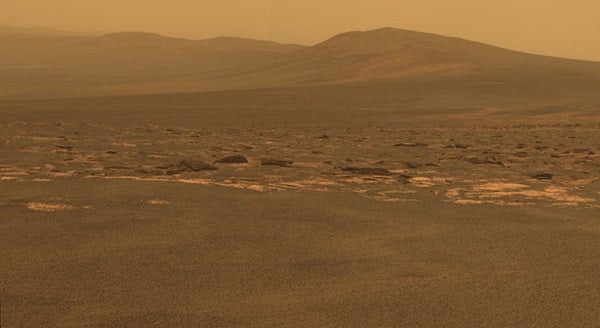On August 9, the golf-cart-sized rover relayed its arrival at a location named Spirit Point on the crater’s rim. Opportunity drove approximately 13 miles (21 kilometers) after climbing out of Victoria Crater.
“NASA is continuing to write remarkable chapters in our nation’s story of exploration with discoveries on Mars and trips to an array of challenging new destinations,” NASA Administrator Charles Bolden said.
“Opportunity’s findings and data from the upcoming Mars Science Laboratory will play a key role in making possible future human missions to Mars and other places where humans have not yet been.”
Endeavour Crater, which is more than 25 times wider than Victoria Crater, is 14 miles (23 km) in diameter. At Endeavour, scientists expect to see older rocks and terrains than those examined by Opportunity during its first 7 years on Mars. Endeavour became a tantalizing destination after NASA’s Mars Reconnaissance Orbiter detected clay minerals that may have formed in an early warmer and wetter period.
“We’re soon going to get the opportunity to sample a rock type the rovers haven’t seen yet,” said Matthew Golombek from NASA’s Jet Propulsion Laboratory (JPL) in Pasadena, California. “Clay minerals form in wet conditions, so we may learn about a potentially habitable environment that appears to have been very different from those responsible for the rocks comprising the plains.”
“Our arrival at this destination is a reminder that these rovers have continued far beyond the original 3-month mission,” said John Callas, from JPL.
NASA’s Mars Reconnaissance Orbiter, which launched August 12, 2005, is searching for evidence that water persisted on the martian surface for a long period of time. Other Mars missions have shown water flowed across the surface in the planet’s history, but scientists have not determined if water remained long enough to provide a habitat for life.
On August 9, the golf-cart-sized rover relayed its arrival at a location named Spirit Point on the crater’s rim. Opportunity drove approximately 13 miles (21 kilometers) after climbing out of Victoria Crater.
“NASA is continuing to write remarkable chapters in our nation’s story of exploration with discoveries on Mars and trips to an array of challenging new destinations,” NASA Administrator Charles Bolden said.
“Opportunity’s findings and data from the upcoming Mars Science Laboratory will play a key role in making possible future human missions to Mars and other places where humans have not yet been.”
Endeavour Crater, which is more than 25 times wider than Victoria Crater, is 14 miles (23 km) in diameter. At Endeavour, scientists expect to see older rocks and terrains than those examined by Opportunity during its first 7 years on Mars. Endeavour became a tantalizing destination after NASA’s Mars Reconnaissance Orbiter detected clay minerals that may have formed in an early warmer and wetter period.
“We’re soon going to get the opportunity to sample a rock type the rovers haven’t seen yet,” said Matthew Golombek from NASA’s Jet Propulsion Laboratory (JPL) in Pasadena, California. “Clay minerals form in wet conditions, so we may learn about a potentially habitable environment that appears to have been very different from those responsible for the rocks comprising the plains.”
“Our arrival at this destination is a reminder that these rovers have continued far beyond the original 3-month mission,” said John Callas, from JPL.
NASA’s Mars Reconnaissance Orbiter, which launched August 12, 2005, is searching for evidence that water persisted on the martian surface for a long period of time. Other Mars missions have shown water flowed across the surface in the planet’s history, but scientists have not determined if water remained long enough to provide a habitat for life.










